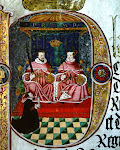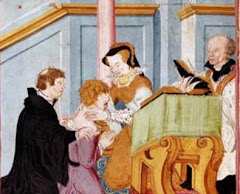
Sir Henry Bedingfield, by unknown artist, 1573. Oxburgh Hall, Norfolk.
Bedingfield, one of Mary's longterm supporters, was a witness of her will.
During her reign, Mary perceived herself to be pregnant on two occasions. The final time was in 1557-8, the last years of Mary’s life and reign. Philip left England in July 1557, and by December Mary was confident enough of her pregnancy to write to him of the news.
On this day in 1558, Mary made her will believing the birth was fast approaching (a due date of early/mid April appears to have been given). This was a customary procedure. Childbirth was rife with danger, so the prospect of the queen and her infant dying in the process was daunting though certainly not unthinkable.
The will can be read in its entirely in David Loades, Mary Tudor: A Life (Oxford, 1989), pp. 370-80. I have broken it down into the key sections:
1. Declaration of faith (standard statement placed at beginning of early modern wills. Provides insight into Mary’s faith)
‘Fyrste I do commend my Soulle to the mercye of Almighty God the maker and Redeemer thereof, and to the good prayers and helpe of the most puer and blessed Virgin our Lady St. Mary, and all of the Holy Companye of Heven. My body I will to be buried at the discression of my executors: the interment of my sayd body to be made in such order and with such godly prayers, Suffrages and Ceremonies as with consideracyon of my estate and the laudable usage of Christ’s Church shall seme to my executors most decent and convenient. Also my mynde and will ys, that during the tyme of my interment, and within oon moneth after my decesse owte of this transitory lyfe, ther be distributed almes, the summe of oone thousand pownds, the same to be given to the relefe of pore prisoners, and other pore men and whomen by the discression of my executors’.
2. States her desire to have her mother’s remains brought to Westminster Abbey so the pair may rest together.
‘And further I will that the body of the vertuous Lady and my most dere and well-beloved mother of happy memory, Quene Kateryn, whych lyeth now buried at Peterborowh, shall within as short tyme as conveniently yt may after my burial, be removed, brought and layde nye the place of my sepulture, In wch place I will my Executors to cawse to be made honorable tombs or monuments for a decent memory of us’.
3. Grants of money to religious houses re-established during her reign, namely the continuation in funds to ‘the oon of Monks of th’ order of Carthusians and th’ other of Nunns Ordines of Stae Brigittae’. Also that ‘the said Religious howses of Shene and Sion’ by granted ‘the summe of five hundred pownds of lawfully money of Englond’, along with other financial provisions. Later she provides assistance to the observant friars of Greenwich (the chapel of which she was baptised in), and to Savoy Hospital founded by her grandfather, Henry VII.
4. Requests for masses to be sung for her soul, her husband’s after the occasion of his death, her mother’s and her royal predecessors ‘namely the said Kynge Henry 5’.
5. Five hundred pounds to the ‘pore Scolers in ether of the Universities of Oxinford and Cambridge’.
6. Asks that her executors ‘provide some convenient howse within or nye the Suburbs of the Cite of London’ which will have ‘onn Master and two Brotherne’ (so three priests). This ‘howse or Hospitall’ would be endowed with lands and money and would be dedicated to aiding the ‘pore, impotent and aged Souldiers’ and those who had fallen into extreme poverty.
7.Asks that all her debts be paid, and all debts accumulated during the reigns of her father, Henry VIII, and brother, Edward VI.
8. States that it is her ‘dewtie to God’ to return to the Church various former church lands where permissible. Mentions Cardinal Pole’s efforts in the return to Rome and commends him to continue this after her demise. (Ironically Pole died on the same day as Mary).
9. Money to be given to her ‘pore Servants’, distrusted at a time when her executors saw fit.
10. Now the important part – her successor. She leaves her realm to the ‘heyres, issewe and frewte of my bodye accordyng to the laws of this Realme’. So her successor is her supposed unborn child. Aware of the possibility of leaving the throne to an infant, Mary provides a regent. This was to be ‘my saide most Dere and well beloved Husband’. She lists her husband’s many virtues, especially his dedication to the Church. She asks for the loyalty shown unto her by her subjects to be transferred to her husband on the occasion of his regency.
11. Near the end of the document she asks her husband to keep several jewels in her memory. This included on ‘table dyamond’ that had been sent to her by Philip’s father, and Mary’s cousin, Charles V. She notes that Philip may do what he wished with these items, including possibly later given them to their child that she believed she carried.
12.Cardinal Pole is given a thousand pounds. Money is also left to various noblemen and other churchmen. Longstanding household attendants are also remembered.
The 'wytnesses' of the will were men who had served her for a number of years and had been her most ardent supporters during her attempts to gain the throne in 1553 (naturally they were also devout Catholics) –
Henry Bedingfield
Thomas Wharton
John Throckmorton
Richard Wilbrahm
So ‘the’ Imperiall Crowne of this Realme’ (Mary does not completely abandon her father’s views), is left to her unborn child and Elizabeth is not mentioned throughout. The following month, Mary realised she was not pregnant. On 28 October 1558, her will was extended to accommodate the change in circumstances. Yet again Elizabeth is specifically not named. Her right is approved indirectly, for Mary states that her successor’s was according to the ‘Laws and Statues of this Realme’. So the 1544 Act of Succession and Henry VIII’s will remained, facilitating the accession of the last, and longest reigning, Tudor monarch.




I am interested in your comments about Lady Burgh's household and would like to find out a little more. I am the current Lady Burgh and my husband thinks that one of his ancestors was head of Ann Boleyns household. Is the the husband of the Lady Burgh you refer to?
ReplyDeleteemmma.burgh@sjpp.co.uk
Thank you for your message! I will email you the information that I have on Lady Burgh (which, I am afraid, is rather limited). I will sent it to the address you provided (but I will try 'emma.burgh@sjpp.co.uk', in case that's the right one)
ReplyDeleteI just had to stop by and say THANKS!!!! I just got my 20 page reseach paper back and i made an A! I would not have done it without your blog. Thanks!!
ReplyDelete